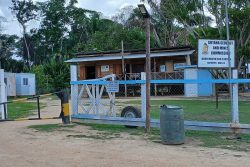The US$300m Vreed-en-Hoop Shorebase Inc (VEHSI) facility on the West Coast of Demerara which encompasses this country’s first man-made island has suffered work delays but it is not expected to affect the current contract arrangement with ExxonMobil or delay offshore works, sources say.
Sources close to the project told the Stabroek News that the project “Is coming in late, in terms of handing over, but this would not affect anything with Exxon and there is no cause for alarm”.
The first phase of the project was expected to be completed by December last year but sources say that there will now be a two-month delay in that aspect, given the technicalities of the work programme and other factors relating to construction.
This newspaper reached out to the company for insight into engineering and other works done here, including an overall update of the project but was told that, “There will no comment from the company at this time.”
In its first phase, the project is expected to add more than 44 acres to Guyana’s coastline. Phase one of the project is meant to be the special purpose vehicle to serve as a SURF (Subsea Umbilicals, Riser and Flow lines) Shorebase for projects of ExxonMobil’s subsidiary, Esso Exploration and Production Guyana Limited.
Some 10 acres were to be made operational by December 2023, with additional acreages delivered by the second quarter of this year. It could mean that this year’s timeline will also suffer setbacks. The long-term vision of the project will see the full Port of Vreed-en-Hoop completed with as much as 800 acres of port facilities.
The last update from the company was in early November of last year when VEHSI had the docking and offloading of the first commercial vessel at its man-made island facility.
A vessel, the M.V. Virtuous Striker became the first commercial vessel to dock at the newly constructed facility and at the same time was registered as the longest vessel, at over 190 meters, to ever enter the Demerara River Channel. Additionally, with a cargo of over 26,900 metric tonnes it was also one of the largest payloads to ever be offloaded, according to the company.
The company did not say if the cargo was related to the infrastructural works that it was undertaking at the facility.
However, the docking and offloading of the vessel marked a major milestone for the 44-acre facility which will primarily serve as a shore base for ExxonMobil projects, the company had stated.
According to one of its directors and partners Nicholas Deygoo “We are very proud of this milestone as it take us closer to becoming fully operational.”
Boyer has also explained that “once fully realized, the Port of Vreed-en-Hoop will tie into the country’s vision to expand Guyana’s development.” He noted that there is space for expansion and VEHSI can facilitate other shore base projects thereby making the need for foreign bases to support operations in Guyana unnecessary.
VEHSI is a joint venture between NRG Holdings Inc.—a 100 percent Guyanese-owned consortium that is the majority shareholder –and Jan De Nul, a Belgium international maritime infrastructure company.
Jan De Nul is responsible for the infrastructural works on the project this newspaper understands.
The NRG Holdings Inc. started as a consortium of three local entrepreneurs, comprising gold miner Andron Alphonso of ZRN Investment Inc; Nazar ‘Shell’ Mohammed, of HADI’S World Incor-porated; and Nicholas Deygoo-Boyer of National Hardware Guyana Ltd. They had in 2022 commenced construction of shorebase facility which would be leased to ExxonMobil to support its offshore oil operations, according to a contract signed in 2021.
But on the heels of an explosive Reuters article that claimed that the Mohameds were engaged in gold and drug smuggling and that that US government officials had repeatedly warned ExxonMobil to avoid doing business with the businessman, HADI’s pulled out of the deal and sold it shares to the other partners. The decision, Nazar “Shell” Mohammed had explained was one based on personal religious beliefs.
Mohamed has maintained that there is no truth in the article and has deemed the report deemed defamatory.
When the sod was turned for the facility it was said that at least 300 jobs would have been generated during the construction phase while the jobs generated during the operation phase will depend solely on the needs of Exxon.
Boyer had said that the construction methodology is heavy equipment-based, so there will be a demand for operators and equipment movers.
Students of the University of Guyana’s Faculty of Technology were last year exposed to reclamation and construction engineering techniques used to create the artificial island, as the company took them on site to see firsthand what was being done.
The students’ visit was in keeping with VEHSI’s commitment to help increase the technical capacity of Guyanese. The company had said that while at the site, the students engaged the construction team on the ground by querying the various techniques, reasons for employing those techniques and the preferences of one material or method over the other, among other pertinent engineering questions about the facility and its construction. The construction team also explained the project’s rigorous construction schedule, environmental compliance and answered questions about qualifications and experience needed to be part of this type of construction project.
ExxonMobil’s Country President Alistair Routledge has also said that that VEHSI is an important project because it would enable investors in the oil and gas sector to do more. He said that VEHSI’s role will be different from that of Guyana Shore Base Incorporated (GYSBI) at Houston. GYSBI is Guyana’s first shore base facility and has enabled Exxon to move almost all of its supply chain for drilling and production operations from Trinidad to Guyana.
He added that some of the fabrication of jumpers and steel plates to go on the seabed to connect the wells are being done in Guyana at a smaller facility – at SAIPEM – but with VEHSI coming on board that would increase capacity significantly.









